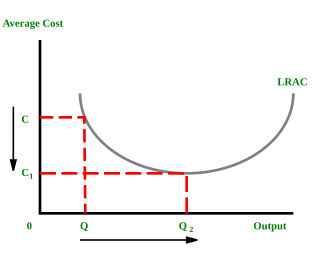Economics
The term and the concept's development are attributed to economists John C. Panzar and Robert D. Willig (1977, 1981). [4] [5] Their 1981 article notes that they had coined the term several years previously, and felt that its logic was "intuitively appealing". [5] : 268
Whereas economies of scale for a firm involve reductions in the average cost (cost per unit) arising from increasing the scale of production for a single product type, economies of scope involve lowering average cost by producing more types of products.
Economies of scope make product diversification efficient, as part of the Ansoff Matrix, if they are based on the common and recurrent use of proprietary know-how or on an indivisible physical asset. [6] For example, as the number of products promoted is increased, more people can be reached per unit of money spent. At some point, however, additional advertising expenditure on new products may become less effective (an example of diseconomies of scope). Related examples include distribution of different types of products, product bundling, product lining, and family branding.
Economies of scope exist whenever the total cost of producing two different products or services (X and Y) is lower when a single firm instead of two separate firms produces by themselves. [7]
The degree of economies of scope formula is as follows:
If , there are economies of scope. It is recommended that two firms can cooperate and produce together.
If , there are no economies of scale and economies of scope.
If , there are diseconomies of scope. It is not recommended for the two firms to work together. [8] Diseconomies of scope means that it is more efficient for two firms to work separately since the merged cost per unit is higher than the sum of stand-alone costs. [8]
For a company, if it wants to achieve diversity, the economy of scope is related to resource, and it is similar to resource requirements between enterprises. Relevance supports the economy by improving the applicability of resources in the merged companies and supporting the economical use of resources (such as employees, factories, technical and marketing knowledge) in these companies. [9]
Unlike economies of scale, "which can be reasonably be expected to plateau into an efficient state that will then deliver high-margin revenues for a period", economies of scope may never reach that plateau at all. As Venkatesh Rao of Ribbonfarm explains it, "You may never get to a point where you can claim you have right-sized and right-shaped the business, but you have to keep trying. In fact, managing the ongoing scope-learning process is the essential activity in business strategy. If you ever think you’ve right-sized/right-shaped for the steady state, that’s when you are most vulnerable to attacks." [10]
Research and Development (R&D) is a typical example of economies of scope. In R&D economies, unit cost decreases because of the spreading R&D expenses. For example, R&D labs require a minimum number of scientists and researchers whose labour is indivisible. Therefore, when the output of the lab increases, R&D costs per unit may decrease. The substantial indivisible invest in R&D may also implies that average fixed costs will fall rapidly due to the output and sales increase. The ideas from one project can help another project (positive spillovers). [11] [12]
Strategic fit, also known as complementarity that yields economies of scope, is the degree to which, or what kind of activities of different sections of an entrepreneur corporates with each other that complement themselves to achieve competitive advantage. Throughout the strategic fit, diversified firms can merge with interrelated businesses and share the resources. These kind of corporations can limit the duplication of research and developments, provide a more planned and developed selling pipelines for businesses. [9]
Joint costs
The essential reason for economies of scope is some substantial joint cost across the production of multiple products. [13] The cost of a cable network underlies economies of scope across the provision of broadband service and cable TV. The cost of operating a plane is a joint cost between carrying passengers and carrying freight, and underlies economies of scope across passenger and freight services.
Natural monopolies
While in the single-output case, economies of scale are a sufficient condition for the verification of a natural monopoly, in the multi-output case, they are not sufficient. Economies of scope are, however, a necessary condition. As a matter of simplification, it is generally accepted that markets may have monopoly features if both economies of scale and economies of scope apply, as well as sunk costs or other barriers to entry.
Advantages
Economies of scope have the following advantages for businesses: [1]
- Extreme flexibility in product design and product mix
- Rapid responses to changes in market demand, product design and mix, output rates, and equipment scheduling
- Greater control, accuracy, and repeatability of processes
- Reduced costs from less waste and lower training and changeover costs
- More predictability (e.g., maintenance costs)
- Faster throughput thanks to better machine use, [1] less in-process inventory, or fewer stoppages for missing or broken parts. (Higher speeds are now made possible and economically feasible by the sensory and control capabilities of the “smart” machines and the information management abilities of computer-aided manufacturing (CAM) software.)
- Distributed processing capability made possible and economical by the encoding of process information in easily replicable software
- Less risk: A company that sells many product lines, sells in many countries, or both will benefit from reduced risk (e.g., if a product line falls out of fashion or if one country has an economic slowdown, the company will likely be able to continue trading)
Empirical Evidence
In a 2022 article in the Journal of Political Economy, researchers used data from the Indian manufacturing sector to estimate the economies of scope arising from factor-biased productivities that are jointly used across product lines. They found that economies of scope are important determinants of product market entry, and that they change entry probabilities by several percentage points. [14]












